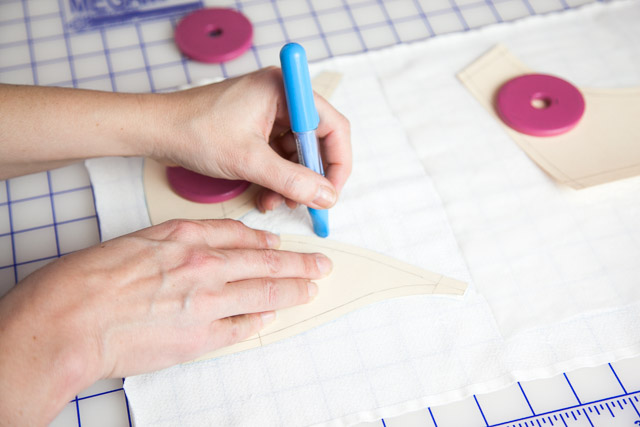
Alrighty, it’s time to get down to cutting! In this post, I’ll be going over the basics in cutting the bra. I also wanted to give you some creative options so I’ll be following this with a separate post on cutting a variation of the cup in scalloped stretch lace.
Check Your Stretch Direction
Before you start cutting, double check your fabrics to determine their direction of greatest stretch. This will help you lay out your pieces in the proper direction. In specialty lingerie and spandex fabrics, the greatest stretch can be in either direction. In several of my lycra and powernet fabrics, for example, the greatest stretch runs down the selvage, which is the opposite of many jersey knits.
Trace & Cut
Before laying out your pieces you’ll want to snip out the notches so you can mark them on the fabric. Weigh your pieces down and trace around them with chalk or pen. Use the chalk or an washable marker to mark the notches.

I keep a variety of marking tools around because some nylon fabrics have difficulty accepting chalk. In those cases I use a ball-point pen. Don’t let that scare you! You’re going to be cutting these lines away so they won’t show. I’ve also been playing with a heat-erasable gel pen, which I discovered via quilting blogs. (You gotta love quilters because they have the best fabric-marking ideas!)
Cut your pieces, making sure to cut your lines away. Here is where I question my choice of ivory-colored fabrics for photo purposes but hopefully you can see my faint chalk lines.
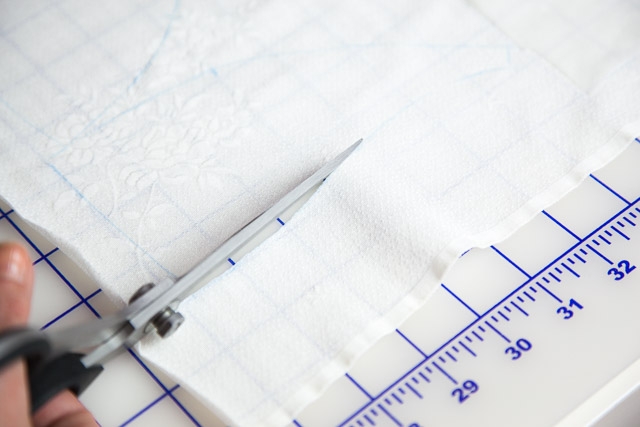
Snip your notches (just a tiny amount—remember your seam allowance is only 1/4”). If your fabric has an open texture, such as lace or mesh, those little cuts won’t be visible, so you can just leave your notch marks un-snipped.
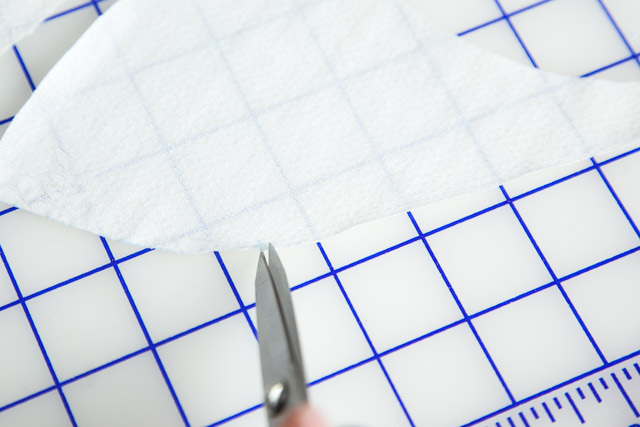
Tip for Cutting the Cradle & Lining
I have a favorite trick for cutting out bra cradles and linings. Since tricot linings tend to be slippery and slightly more difficult to cut, I like to cut them as a single layer rather than on the fold. This means that I need to trace two sides of my cradle pattern so I have one piece, which you’ll see below. To make cutting even easier, I place the lining on top of the main cradle fabric, trace the cradle onto the top layer, remove the pattern, and cut the two layers together using a rotary cutter.
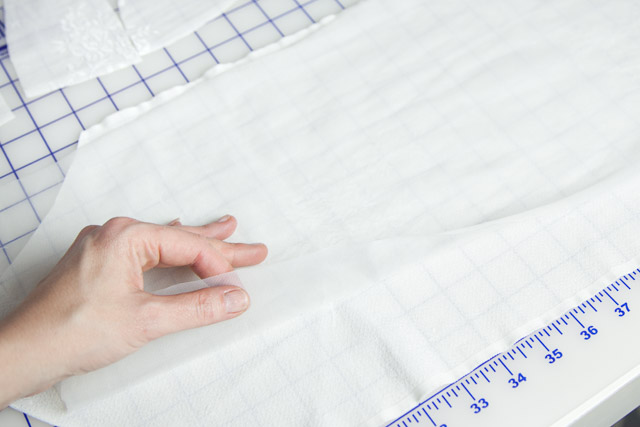
Ready to trace…

If you have chosen to use a fusible interfacing instead of a lining for the cradle, you can do the same thing. Just place your interfacing glue side down on to the wrong side of your cradle fabric, trace onto the interfacing and cut them together. Then fuse. Alternatively, you can blockfuse: in blockfusing, you fuse a rough cut of interfacing big enough for your pattern piece to a piece of fabric, then cut the pattern from the pre-fused piece. I’m a fan of blockfusing in all kinds of sewing. It really makes cutting so easy!
Finish cutting your band pieces from your chosen fabrics and that’s it!
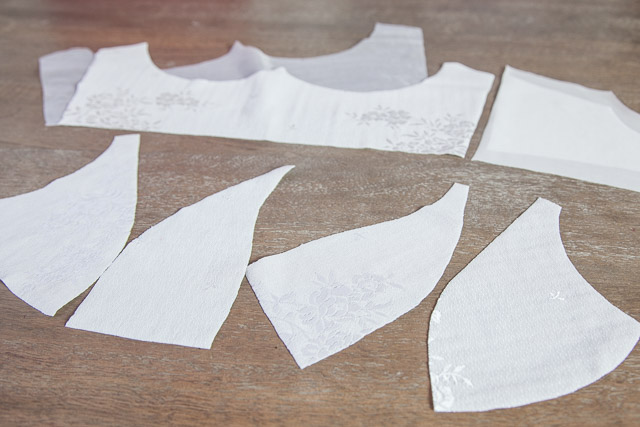
The Role of Bra Linings
Before I sign off, I had a few questions about whether or not one could leave out the lining on the cradle. It may help to explain the role of linings.
In supportive bra designs, linings serve two purposes: they help the bra last longer and very importantly, they stabilize areas of stretch so that they have less stretch, or no stretch. One of those areas is the space between or underneath the cups. This stabilization keeps the cups in place and in underwired bras, helps the wires stay in position.
Bras that are designed to slip over the head, such as a camisole-style bra, tend to be less supportive. Their bands need to be stretchier by design in order to slip on without a hook & eye. The Watson is designed to have a firm band fit, which includes a stable front cradle. However, if you wished to create a softer bra and leave out the lining, I recommend testing this first because it will change the fit. The band will be looser and stretchier, and the cups will shift around and possibly want to spread apart. This also depends on size—small cups have less weight so it’s easier for the cups to stay in place.
I hope this helps make sense of linings!
Would you like tips and inspiration in the craft of lingerie sewing? Sign up for my weekly eletter The Lingerie Maker.

Hi Amy, I am following this sewalong with great interest, although I haven’t time at the moment to join in (I am saving all the posts for later though!) I just wanted to ask you this time about your gorgeous pattern weights – are they hand-made or painted? I have come across some scientific weights which look a little similar. I love your blog and your beautiful, clear explanations.
Thank you Stella! I am often asked about these weights. They are metal with a nylon coating that keeps them from moving around. I bought them from a quilting shop many years ago and would love to have more but cannot seem to find them anywhere. I suspect they are no longer made. (They might have been Dritz brand?)
Hi Amy, Thanks for replying so quickly! As you can’t find those weights again (what a shame), this is what I was thinking of buying in case they might interest you or anyone else – they are very cheap but not as pretty…maybe I will paint them pink! This a UK company, but I am sure they can be found anywhere.
http://www.hope-education.co.uk/product/Slotted-Masses–1kg-Spare-Slotted-Masses–100g-HE1003086
I would like to pitch in and suggest to look for similar pattern weights on etsy.com. I found some adorable ones there.
When I am using a pattern that I know I am going to use for years, like the watson is going to be, I print it in a common foil. After that, glue it in a board or felt paper (I don´t know how to say it because my language isn’t English, I want to say a thick paper) with all the notches and indications the maker did, but it is going to last more.
Hi Amy,
I just had a quick question about the bra cradle lining. Could I use Nylon Tricot instead of Tricot lining? Or is it all the same thing?
Thanks!
HI Brigid, yes you can! Stores use different names for them but they are all basically the same thing. Tricot refers to the way it is knitted. The nylon is the fiber content. In my materials post (at the bottom), I wrote about a few different types.
Oh thanks so much Amy! Now I’m super excited to cut out my bra!
So, this is my very first bra, one of my first projects with a pattern, and I have what might be considered a silly question by many more experienced sewists. Is the seam allowance built into the pattern to print off, or am I to add that when tracing and cutting out the pattern?
I’m absolutely loving this sew-along. I tend to learn by jumping in the deep end and learning how to swim, and I’ve been wanting to learn how to make lingerie for over a year now. Thank you for all the work on this and the help!
Hi Kathryn, they are included. In the pattern instructions, at the top of the sections for both the bra & bikini there are boxes which state what seam allowances are used and where. You may also want to look at this post on alterations where I go over the seam allowances.
I also learn by jumping off the deep end! I have fun that way, messes and all.
It has all the seam allowances you´ll need. Have a fantastic sew alone. And thank again Amy.
I’m excited! I recently bought the pattern. I finally have a lovely red kit from my local fabric store. I’m prepared to trace and cut tonight:)
Stella, an inexpensive option for pattern weights is hockey pucks. They’re heavy enough to hold pattern and fabric without being too heavy. And the rubber coating doesn’t slip.
Wow, thanks Toni! I will research those – they sound perfect.
Amy,
Any wisdom about how to keep the sheer lining from slipping from the cradle? I bought the sheer cup lining you suggested and wow have I had a difficult time with this stuff. Tried machine basting–too much slippage, then tried hand basting–that didn’t work either. Got the brilliant idea of fusing “misty fuse” between the fabric and lining and made a mess. I have to cut another cradle. I did buy some fusible interfacing, so perhaps that is the way to go?
Hi Betsy, when we get to sewing the bra (Thursday), I have a few tips on sewing with these fabrics and particularly the cradle. I’ll save them for then just so everyone else with the same problems gets to see this.
A fusible would definitely be easier to handle so that is why I offered it as an alternative. I prefer to line my cradles as this is the more traditional bra-making method–it helps the fabric maintain its hand and texture. Some fusibles, depending on quality, may start to separate from a 4-way stretch fabric. As with any fusible, experiment with it by fusing some scraps and seeing how it works with the fabric.
Thank you. I realized as soon as I posted, I should have been patient. I’ll cut again and wait for your tutelage!
Hi Amy, I feel like a bit of an idiot, but I figured I’d finally ask you this anyway. I’ve just reread this post and the post on materials and I’m still unsure about the desired properties for the cradle lining. As you know, I can’t get the proper technical lingerie fabrics locally and am trying to make a bra from natural materials. What can I substitute for the cradle lining? On my first Watson, I just doubled up the jersey I used for everything else, but from rereading your posts, it seems to me that the cradle lining is not supposed to stretch at all? So should I substitute a non-stretch (perhaps a woven??) fabric for it, or is it okay to double up my main fabric after all? Thank you! I know I’m terribly easy to confuse!
Hi Jana, these are great questions! For many people bra-making materials are a foreign experience because as you say they are more technical fabrics. In a lining, desirable properties are: lightweight, somewhat flexible, doesn’t stretch in at least one direction. Tricots are usually the first choice because they hold all these properties and are easy to care for. I think my first choice in a natural fabric lining might be a lightweight silk, perhaps a silk organza. (I’d wash it in warm water to remove some of the stiffness.) However, if you like the bra without the non-stretch cradle then that’s perfectly okay!
On a side note, I often say that bra-making is still a niche specialty craft and as such many of the traditional materials are only available in niche stores. I can’t find most of my materials locally so I shop online. But it’s fun to experiment with more readily available alternatives, too.
Thank you so much, Amy! Your support and this sew-along are ace! I’ll go dig out fabric for my second attempt and try to catch up with you!
Hi Amy
I’m in Australia and have bought fusiable (iron-on) interfacing. When i told the shop owner she told me that i wouldn’t be putting that directly on my skin and that it would be on the inside of two layers. Obviously your pattern doesn’t suggest this. Am I crazy or is the shop owner confused?
Hi Larissa,
That’s a great question. Do you happen to know what type of interfacing it is? Was it made for knits? (There are many different types.)
Perhaps she was thinking of typical uses and bras are an unusual use for it. I have pulled out bras on many a local shop owner to show them what the materials look like! The most common uses for fusible interfacing are places like the inside of waistbands or other areas of a garment that will be lined, so it typically does not sit on the skin. However, if the interfacing is a knit, you’ll be just fine. It’s just fabric with glue on one side. 🙂
Typically, bra cradles are not fused and instead lined with a type of tricot knit. Because these kind of linings can be hard to find I included fusible knit interfacing as a suitable alternative. There are some common fusible interfacings that are basically the same thing as the sheer linings used in lingerie, except with glue on one side. These are often sold as suitable for knits.
So all that to say – there’s nothing wrong with interfacing being against the skin ;). I only have one type that I wouldn’t want near my skin and it’s the really stiff stuff used for jackets!
Just purchased the pattern, got it printed and ready to be sewn, then came across an issue that probably has a solution/explanation that I’m overlooking, lol.
I’ve printed the pattern twice, making sure the scaling was correct both times (the test square correctly measured 5″). But both times the edge of the band piece is longer than the edge of the cradle piece (for reference, I’ve cut the 30g size and the cradle edge is approx. 6″ in length and the band edge is 6 1/4″. In comparing band/cradle edge lengths in all the sizes I’ve noticed the same issue).
Is this normal? If so, when I sew the band pieces to the cradle how do I line them up? Matching the top edge with the excess at the bottom? Or match the bottom edge with the excess at the top?
I ask because the illustration in the pattern booklet for sewing the band to the cradle shows two pieces that match exactly. Thanks for any help!
Hi Emme, I responded to your email but want to respond here in case someone else has the same question!
My patterns include seam allowances and on the Watson they are noted on page 8 of the pattern, at the top of the instructions. I also describe them in this sew-along post, along with how to mark where they are: https://clothhabit.com/watson-sewalong-bra-fitting-alterations/
All the seamlines–the actual stitching lines–match precisely. However, as you have noticed, the outer edges–the cut edges of the seam allowance–will not. This is normal in all kinds of sewing patterns, unless you are sewing two perfect squares or rectangles together. Don’t try to line up the outside edges when you are sewing, but instead line up the edges where the stitching line starts.
Scroll down to the first photo in this post after the section “Stitch the Band to the Cradle”. If you look closely at the side seam, you will see that the side edges aren’t lined up but the area 1/4″ inside the edge does from top to bottom.
I hope that helps!